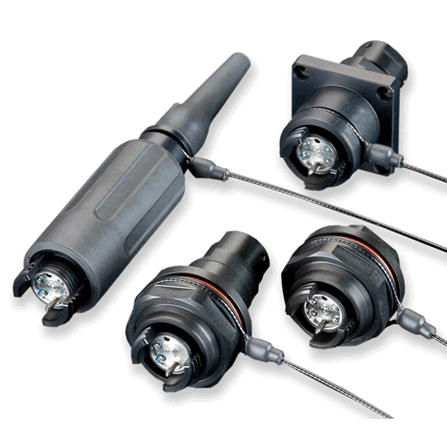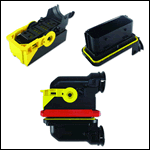Ruggedized Fiber Optics in Military-Grade Systems
Traditionally, copper connectors have been the mainstay technology in military applications. Find out how ruggedized fiber optics in military-grade systems can outperform copper.

Ruggedized Expanded-Beam Optical Cable Assemblies from Molex address the need for high reliability and easy-to-use connectors in demanding harsh environments.
In mission-critical military systems, equipment failure and unplanned downtime cannot be tolerated. Traditionally, copper connectors have been the mainstay technology in military applications – withstanding the test of time due to their ability to handle extreme environmental exposure – but there is another high-performance alternative available.
Today’s military is changing. As has occurred in industrial, marine, automotive, and other demanding industries, the military is becoming increasingly dependent on large data to drive its radar, avionics, and surveillance systems, and those systems are demanding higher data transmission rates over longer distances, which fiber optics can provide.
Vast Improvements in Fiber Connectivity
Fiber optic connector technologies for military-grade systems have changed and emerged as a strong contender to compete with copper. A key benefit of non-conductive fiber, along with bandwidth capabilities, is immunity to EMI/RFI. Transmitted optical signals are unaffected by the surrounding electronics/electrical environment, which positively impacts performance and security. Current ruggedized fiber optic solutions are now allowing for high-speed, high-density links in military applications. Switching from traditional molded plastic components to a sealed metal exterior shell better equips assemblies by protecting fiber from extreme environments and elevated shock, vibration, and temperatures. Fiber interconnects are now available with IP-ratings up to IP68, with some manufacturers offering hermetically sealed fiber interconnects for total protection against dust and prolonged immersion under pressure. Temperature ranges of -60°C to +150°C plus are not unheard of.
Fiber Size, Weight, and Power Advantages
Military-grade fiber optics compare favorably to copper in critical SWaP areas:
- Size – Fiber interconnects and cables can be dimensionally smaller than copper interconnects and cable assemblies with comparable or higher transmission rates.
- Weight – Lightweight fiber benefits payload and fuel usage in military vehicles. Weight reduction also benefits personnel who carry equipment.
- Power – Fiber provides exceptional bandwidth transmission over distances, which is crucial in applications requiring sustained high signal integrity during upload/download of video and data files.
Ruggedized Fiber Maintains Peak Performance
Debris or potential FOD – foreign object damage – is a real concern in any fiber connector application. Dirt, dust, mud, high humidity, moisture, and oil can all foul up traditional optical interconnects in harsh environments, which may lead to system performance issues. Returning interconnects to a state of cleanliness to achieve optimal performance has typically required maintenance by trained technicians using special tools, solvents, and cleaning materials. Design engineers should consider how easily interconnects can be maintained when they specify a fiber optic solution. Working in a military base depot or in a hangar provides reasonable protection when maintenance is required. Working in tightly confined spaces of vehicles, in the field, or on a tarmac is more demanding. Newer types of fiber optic assemblies no longer require specialized cleaning tools, which simplifies maintenance tasks for personnel working under adverse conditions.
A connector gaining traction in military and other rugged applications relies on an innovative technology. Able to withstand thousands of mating cycles, “expanded beam” connectors work by utilizing fixed lenses that expand and collimate the light emitting from optical fibers across a sealed connector interface. Rather than a traditional physical butt-mate, there is an air-gap between the two aligned fibers, so the active area of the light beam is much larger than the original optical fiber core. As a result, the optical path or mode in expanded beam connectors is less sensitive to data transmission interruption due to dirt or other foreign matter. Fixed lenses also make cleaning easier and safer. Field technicians never need to touch actual fibers, thereby reducing risk of fiber core damage. Peak performance can be maintained even in an outdoor/field installation.
Cost-Effective Fiber Optic Interconnects Excel
Using a well-designed fiber optic interconnect streamlines installation at the production level and follow-on field maintenance, impacting overall system costs. The ruggedized VITA 66.1 backplane connector is one example of efficient design in a connector. It utilizes the proven MT ferrule for high density with a small board footprint. Some versions of VITA 66.1 do not require any special tools to install or maintain the connectors, which is a cost advantage in assembling a card or backplane, and also an advantage to field personnel who don’t always have immediate access to specialized tools when servicing needs arise.
All branches of the military are in various stages of upgrading to advanced electronic systems. Due to limited transmission distance along with the associated weight factor, traditional copper cabling simply can’t provide the SWaP characteristics required in many of the changing military applications and environments. With all of the recent advances by interconnect manufacturers, there’s never been a better time to deploy ruggedized fiber optic interconnects.
Fiber optics provide immunity to EMI and RFI along with enhanced transmission distance, as well as a lighter-weight package and improved bandwidth performance in numerous and varied devices, including applications in line-replaceable units (LRUs) on aircraft, military command center servers, communication boxes on ground vehicles and tanks, plus land, sea, and airborne-based radar systems. Design engineers should work closely with a reputable manufacturer and keep in mind a number of key design variables when selecting fiber optic connectors – performance in harsh conditions, SWaP characteristics, cost of installation, and maintenance requirements for field personnel.
Mark Matus is global product manager for rugged interconnects at Molex.





